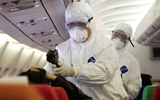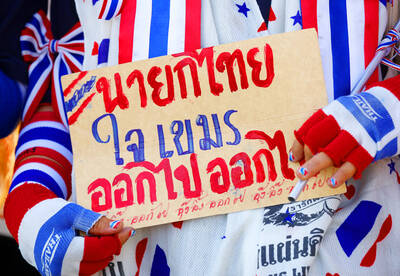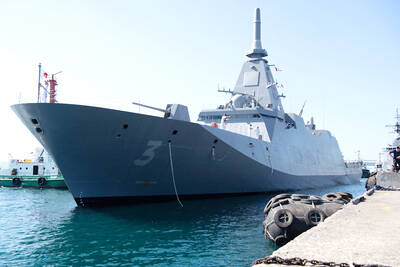The WHO has added 439 new cases of swine flu to its global tally, raising its total of confirmed cases to 12,954. The agency also raised the overall death toll by one to 92.
The WHO said yesterday 46 countries had reported laboratory-confirmed cases of the virus. About half of all cases were in the US.
Authorities in Mexico announced three more swine flu deaths and the US and Canada one more death each. Puerto Rico and the Czech Republic confirmed their first cases of swine flu on Monday but were not yet included in the WHO tally.

PHOTO: AP
Meanwhile, the world’s largest vaccine maker signed a deal with the US to produce a swine flu vaccine.
Sanofi Pasteur said it had won a US$190 million order from the US government to make a swine flu vaccine. The company, which operates flu vaccine production plants in Swiftwater, Pennsylvania, and Val de Reuil, France, said it was also talking to other governments about their vaccine needs.
The company is awaiting a seed virus to be used in vaccine production from the US Centers for Disease Control and Prevention and could begin commercial production next month.
In the US, federal health authorities have confirmed 6,700 swine flu cases, most of them mild. But New York health officials reported another death over the weekend.
Damon Arnold, director of the Illinois Department of Public Health said the latest victim, a Chicago-area resident, had other medical conditions, but authorities released no other information about the person.
In Canada, officials said on Monday that a Toronto man who had swine flu but also suffered a chronic medical condition died on Saturday.
Mexico’s Health Ministry on Monday confirmed a rise in the country’s flu deaths to 83, with more than 4,458 confirmed infections from the virus.
Honduras, Iceland and Kuwait meanwhile reported infections to the WHO for the first time, with Honduras and Iceland posting a case each and Kuwait reporting 18 cases in US soldiers who had since left the country.
In Hong Kong, officials confirmed two new cases of swine flu in young children who arrived on a flight from New York on Sunday, raising the city’s total number of cases to nine.
Also stemming from a New York infection, the Czech Republic registered its first swine flu case involving an adult male from Prague who recently came back from the US city.
Worldwide, fears grew while attempts to contain the disease continued. Japanese shops ran out of face masks amid the outbreak as local authorities and bloggers offered tips on making homemade masks from kitchen paper, coffee filters and even sanitary pads.
The western city of Tatsuno posted handy hints on its official Web site on fashioning a basic anti-flu mask from gauze, tissue and a pair of rubber bands.
Latin America saw most of the new swine flu cases on Monday, as Ecuador’s infected tally rose to 24 over the weekend after officials reported 10 on Friday. Peru raised its confirmed swine flu cases by two to 27.
In China, authorities confirmed two more cases of the swine flu in a 19-year-old man in Zhejiang Province and in a 30-year-old Shanghai man.
In South Korea, the 22nd confirmed case of swine flu followed a sharp weekend rise in reported infections.

Eleven people, including a former minister, were arrested in Serbia on Friday over a train station disaster in which 16 people died. The concrete canopy of the newly renovated station in the northern city of Novi Sad collapsed on Nov. 1, 2024 in a disaster widely blamed on corruption and poor oversight. It sparked a wave of student-led protests and led to the resignation of then-Serbian prime minister Milos Vucevic and the fall of his government. The public prosecutor’s office in Novi Sad opened an investigation into the accident and deaths. In February, the public prosecutor’s office for organized crime opened another probe into

RISING RACISM: A Japanese group called on China to assure safety in the country, while the Chinese embassy in Tokyo urged action against a ‘surge in xenophobia’ A Japanese woman living in China was attacked and injured by a man in a subway station in Suzhou, China, Japanese media said, hours after two Chinese men were seriously injured in violence in Tokyo. The attacks on Thursday raised concern about xenophobic sentiment in China and Japan that have been blamed for assaults in both countries. It was the third attack involving Japanese living in China since last year. In the two previous cases in China, Chinese authorities have insisted they were isolated incidents. Japanese broadcaster NHK did not identify the woman injured in Suzhou by name, but, citing the Japanese

YELLOW SHIRTS: Many protesters were associated with pro-royalist groups that had previously supported the ouster of Paetongtarn’s father, Thaksin, in 2006 Protesters rallied on Saturday in the Thai capital to demand the resignation of court-suspended Thai Prime Minister Paetongtarn Shinawatra and in support of the armed forces following a violent border dispute with Cambodia that killed more than three dozen people and displaced more than 260,000. Gathered at Bangkok’s Victory Monument despite soaring temperatures, many sang patriotic songs and listened to speeches denouncing Paetongtarn and her father, former Thai prime minister Thaksin Shinawatra, and voiced their backing of the country’s army, which has always retained substantial power in the Southeast Asian country. Police said there were about 2,000 protesters by mid-afternoon, although

MOGAMI-CLASS FRIGATES: The deal is a ‘big step toward elevating national security cooperation with Australia, which is our special strategic partner,’ a Japanese official said Australia is to upgrade its navy with 11 Mogami-class frigates built by Japan’s Mitsubishi Heavy Industries, Australian Minister for Defence Richard Marles said yesterday. Billed as Japan’s biggest defense export deal since World War II, Australia is to pay US$6 billion over the next 10 years to acquire the fleet of stealth frigates. Australia is in the midst of a major military restructure, bolstering its navy with long-range firepower in an effort to deter China. It is striving to expand its fleet of major warships from 11 to 26 over the next decade. “This is clearly the biggest defense-industry agreement that has ever